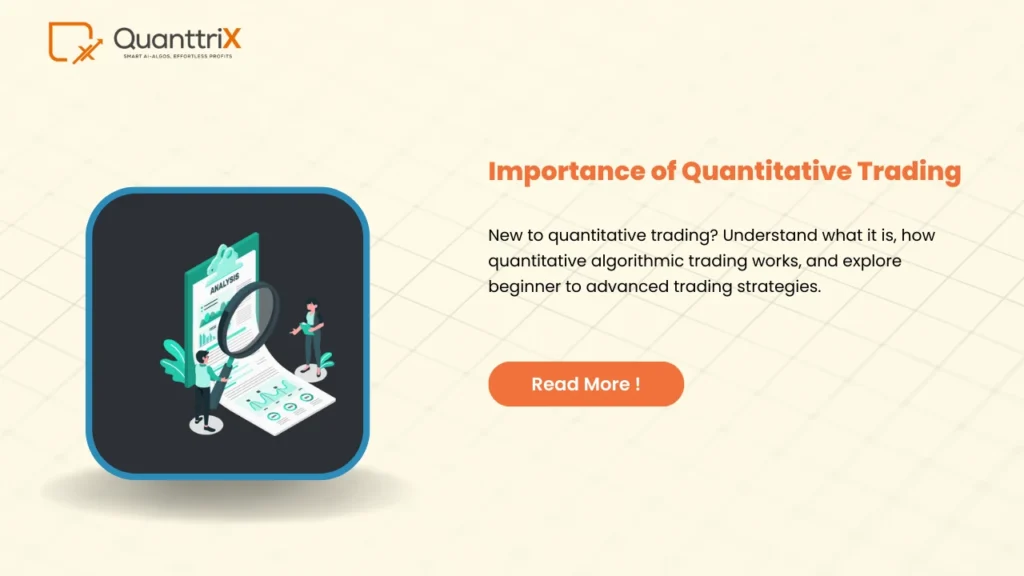The Importance of Quantitative Trading: A Beginner’s Guide
Introduction
Have you ever wondered how some traders seem to consistently stay ahead in the stock market, even while others lose money? Well, chances are, they’re using something smarter than gut feeling or guesswork—they’re using quantitative trading. In a world where data is king, this modern method of trading is changing the game for everyone, not just Wall Street experts.
Think of it like driving with Google Maps instead of just guessing your route. With quantitative algorithmic trading, you’re not just making trades—you’re following a data-backed GPS that helps you reach your destination smarter and faster.
Let’s explore how this works, why it’s important, and how tools like artificial intelligence for trading and the best software for trading in India are making this accessible to everyday people.
Explore the power of quantitative algorithmic trading, best software for trading in India, and artificial intelligence for trading simplified for everyone.
What is Quantitative Trading?
Quantitative trading—often called “quant trading”—is the use of math, statistics, and computer programs to make trading decisions. Instead of relying on gut feelings or news headlines, quantitative traders depend on hard data.
Imagine if you could study thousands of stock trends at once, analyze their behavior, and make a move based on patterns—not emotions. That’s what quant trading does.
How Does Quantitative Trading Work?
At its core, it involves:
- Data Collection: Gathering large sets of historical market data.
- Analysis: Applying statistical models to find trading opportunities.
- Algorithm Design: Creating rules-based systems (algorithms) to execute trades.
- Automation: Letting the system run without constant human supervision.
It’s like setting up a smart coffee machine that knows when you wake up and brews coffee before you open your eyes. Once programmed, it does the work for you.
Why Is It Gaining Popularity?
In a world overflowing with data, using only human intuition is like bringing a knife to a gunfight. Quant trading:
- Removes emotional bias.
- Allows faster decision-making.
- Can analyze far more information than a human can.
That’s why it’s gaining traction, even among everyday investors.
The Role of Data and Math in Trading
Numbers don’t lie. Quant trading uses data like:
- Price movements
- Volume trends
- Technical indicators
These are fed into statistical models that predict future behavior. You don’t have to be a math genius, but understanding that every trade is backed by solid logic and proven models gives peace of mind.How Algorithms Drive Smarter Decisions
Algorithms are step-by-step instructions written in code. In quant trading, they:
- Monitor markets 24/7.
- Execute trades when specific conditions are met.
- React in microseconds—much faster than any human could.
They’re like autopilots on an airplane. You still need to plan the journey, but they handle the controls with precision.
Artificial Intelligence in Quantitative Trading
Enter Artificial Intelligence (AI)—the brain behind the brawn. AI brings the ability to:
- Learn from past trades (machine learning).
- Adapt strategies based on real-time changes.
- Spot patterns humans can’t see.
When you combine AI with quantitative strategies, it’s like giving your autopilot the ability to learn and adjust mid-flight. Powerful, right?
Comparing Traditional vs. Quantitative Trading
| Feature | Traditional Trading | Quantitative Trading |
| Emotion | High | Minimal |
| Speed | Slower | Lightning-fast |
| Decision-making | Human-based | Data-driven |
| Scalability | Limited | High |
| Consistency | Varies | High |
Who Can Use Quantitative Trading?
You don’t have to be a hedge fund manager. Thanks to technology, retail investors (like you and me) now have access to tools that make quant trading possible.
If you’ve ever used a stock trading app, you’re already halfway there. All you need is the right knowledge and software.
Benefits for Individual Traders
Why should everyday traders care? Here’s why:
- No emotional rollercoaster: Trades are made logically.
- Higher consistency: Because it sticks to a proven plan.
- Time-saving: You can “set it and forget it” with automation.
In short, it gives individuals an edge they never had before.
Risks and Challenges to Know
Like any tool, quant trading isn’t foolproof. Key risks include:
- Overfitting: Models that work on past data might fail in real markets.
- Technical issues: A bug in your algorithm could cost you.
- Market changes: Strategies need constant updates.
The trick is to keep learning and test everything in a simulated environment before going live.
Best Software for Trading in India
Let’s talk tools. Some of the best software for trading in India that support quant strategies include:
Zerodha Streak
- User-friendly for beginners.
- No coding needed.
- Great for testing strategies.
Quanttrix
- Built specifically for algorithmic and quant trading.
- Offers AI-based tools.
- Advanced customization for pros.
AlgoTest
- Ideal for backtesting strategies.
- Real-time execution.
- Affordable and widely used.
Upstox API + Python
- Requires coding knowledge.
- Great for custom strategies.
- Scalable for serious traders.
These platforms are like the toolbox in a smart investor’s kit—each has its specialty.
Getting Started: What You Need to Begin
If you’re ready to dive into quantitative algorithmic trading, here’s your starter pack:
- Basic understanding of trading and technical analysis.
- Access to software like those mentioned above.
- Willingness to learn (there are free tutorials and courses online).
- Patience and discipline, as even the best models take time to work.
Future of Quantitative Algorithmic Trading
The future looks exciting. Here’s what’s on the horizon:
- More AI integration for adaptive learning.
- Wider accessibility thanks to mobile apps.
- Blockchain-based smart contracts for transparent and secure trades.
We’re moving toward a world where even your smartwatch could suggest your next trade.
Tips for Success with Quant Trading
Want to improve your chances of success?
- Start small: Use demo accounts before real money.
- Backtest thoroughly: Test strategies with past data.
- Stay updated: Follow market news and technology trends.
- Keep learning: Markets evolve, and so should you.
Final Thoughts
Quantitative trading isn’t just for financial wizards anymore. With the rise of AI, easy-to-use platforms, and accessible tools, it’s becoming the new normal for smart investing. Whether you’re a student, a 9-to-5 employee, or a full-time trader, this method offers clarity, control, and a way to grow your wealth logically.
Ready to give it a try? Remember, in trading—as in life—those who plan ahead tend to go farther.
FAQs
What is the difference between quantitative and artificial intelligence for trading?
Quantitative trading involves using data and math to form strategies, while algorithmic trading is about executing those strategies automatically. Often, they go hand-in-hand.
Do I need to know coding to do quantitative trading?
Not necessarily. Many platforms like Zerodha Streak or Quanttrix offer no-code or low-code options perfect for beginners.
Is quantitative trading safe for beginners?
Yes, if done carefully. Start with demo accounts, backtest your strategies, and never invest money you can’t afford to lose.
How does AI help in trading?
AI can analyze huge datasets, adapt to market changes, and even learn from mistakes—making your strategy smarter over time.
Which is the best software for trading in India using quant strategies?
Quanttrix, Zerodha Streak, and AlgoTest are top contenders. Choose based on your experience level and specific needs.





